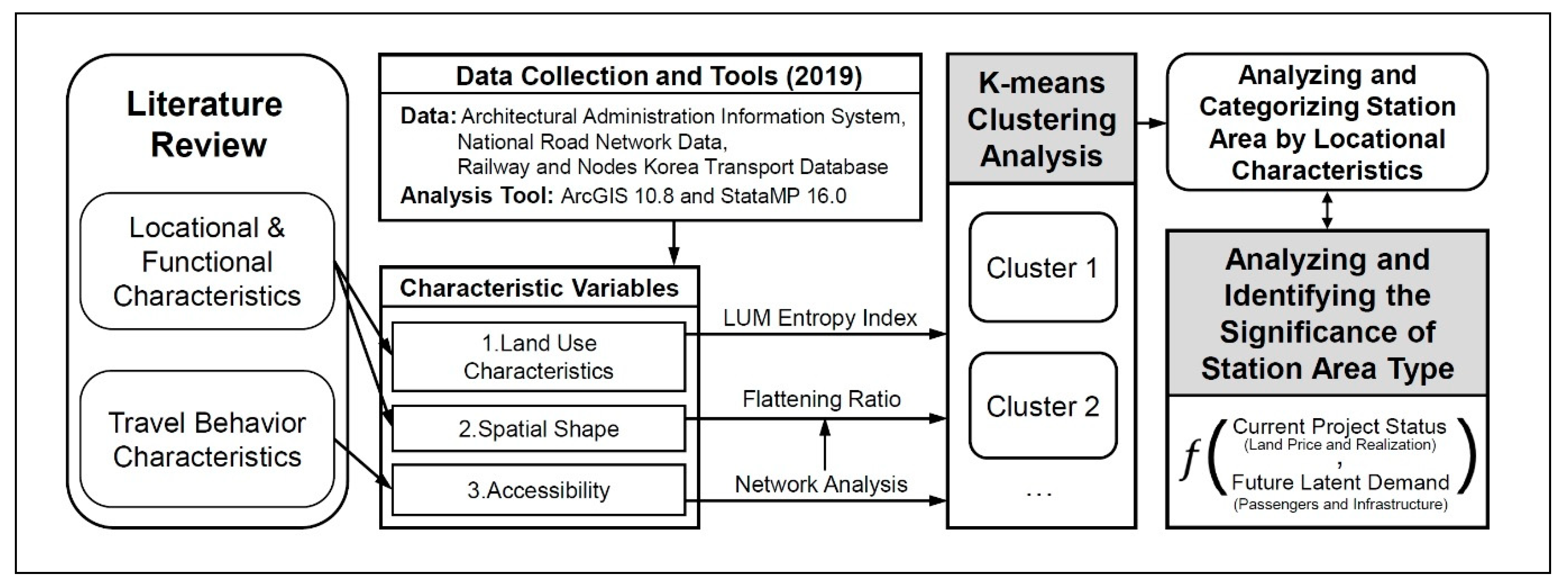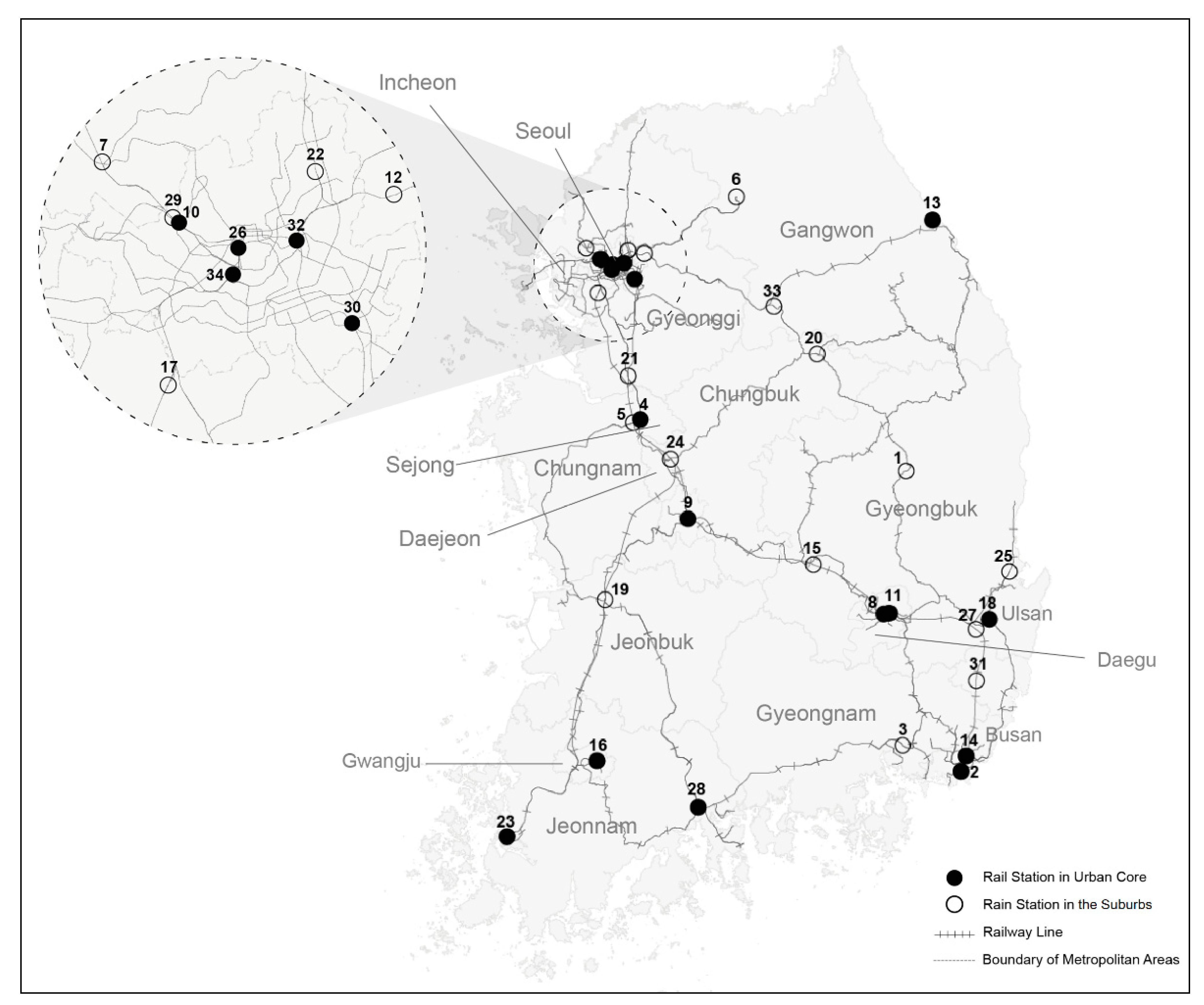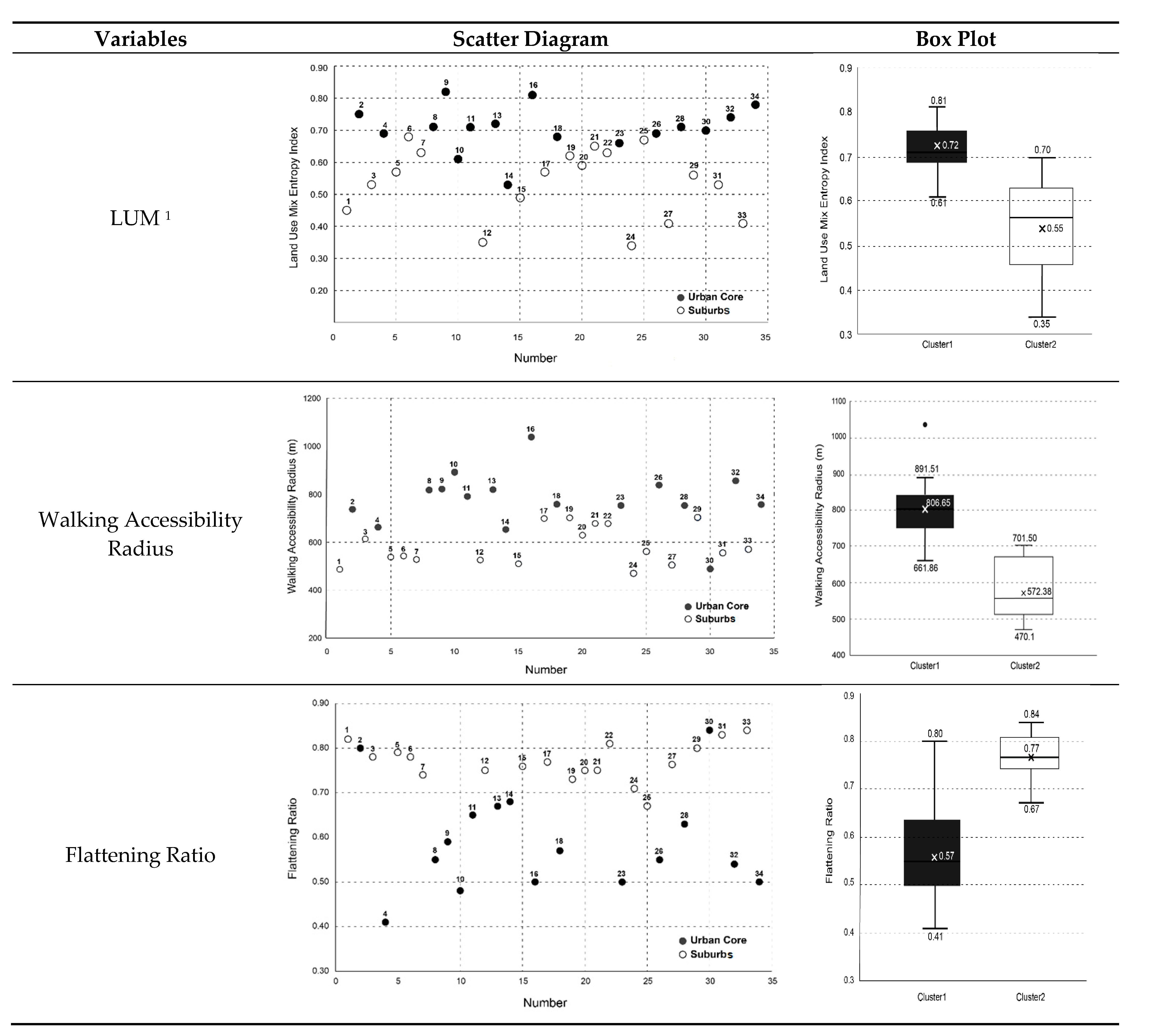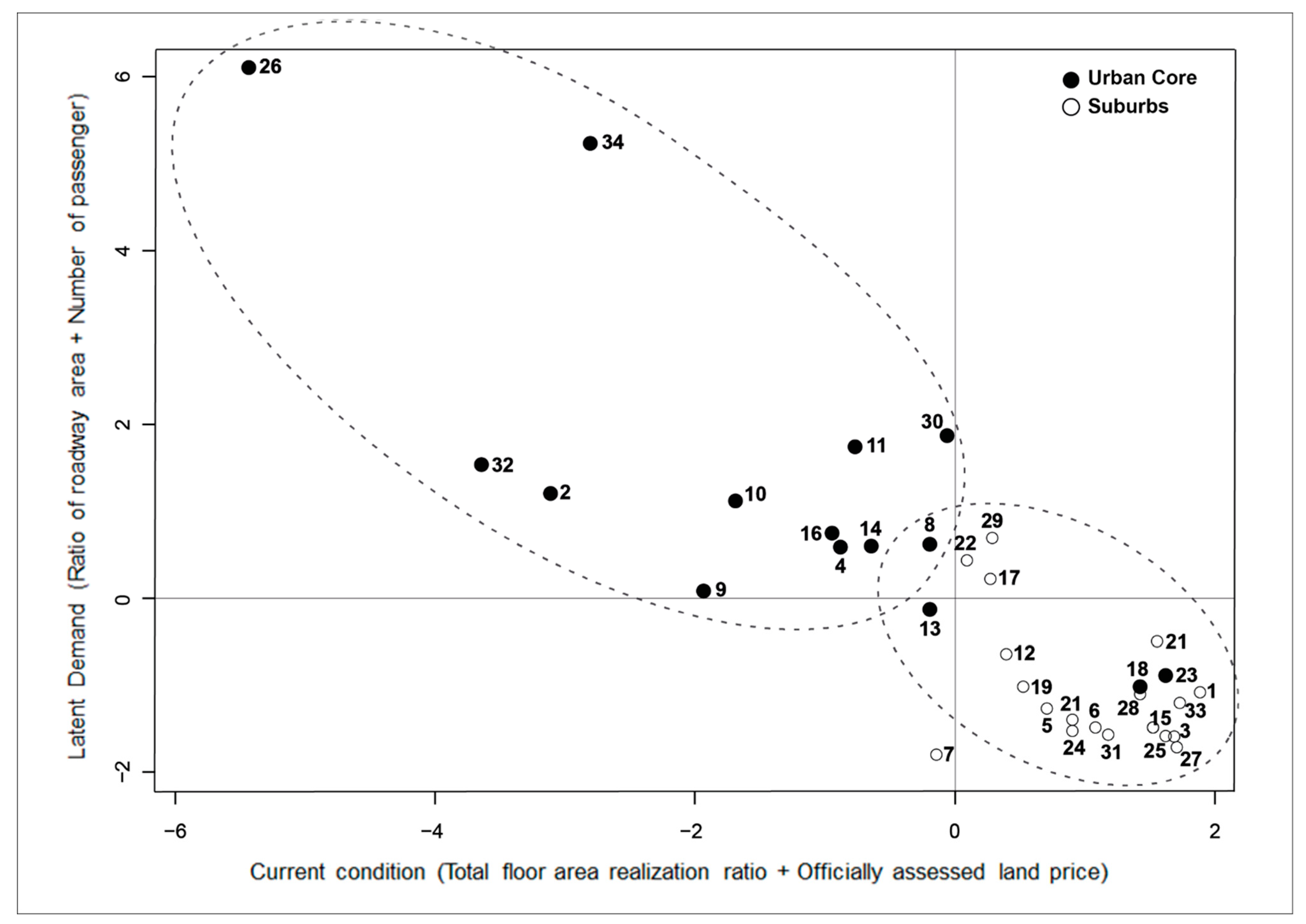Typological Differences in Railway Station Areas According to Locational Characteristics: A Nationwide Study of Korea
Abstract
:1. Introduction
2. Literature Review
2.1. Station Area Scope Setting and Location Functional Characteristics
2.2. Travel Behavior Characteristics and Accessibility
3. Data and Methods
3.1. Selecting Station Areas for Categorization
3.2. Variables Included under Locational Characteristics and their Measurement Methods
3.3. K-Means Clustering Analysis for Categorization
4. Results and Discussion
4.1. Results of Analyzing Station Area Categorization according to Locational Characteristics
4.2. Results of Identifying the Significance of Station Area Types Classified by Locational Characteristics
4.3. Discussion on a Differential Approach of the Station Area Type in Planning and Development
5. Conclusions
Author Contributions
Funding
Institutional Review Board Statement
Informed Consent Statement
Data Availability Statement
Acknowledgments
Conflicts of Interest
Appendix A
| Cluster Type | Station Area | Current Project Status | Future Latent Demand | ||
|---|---|---|---|---|---|
| Total Floor Area Realization (%) | Officially Appraised Land Price | Ratio of Roadway Areas (%) | Number of Passengers (Millions/Year) | ||
| Cluster 1 | Busan | 18.1 | 4960 | 30.1 | 24.13 |
| Cheonan | 21.7 | 1560 | 25.0 | 6.02 | |
| Daegu | 18.3 | 3060 | 19.5 | 5.41 | |
| Daejeon | 18.1 | 1510 | 23.6 | 19.54 | |
| DMC | 19.4 | 4150 | 23.1 | 17.38 | |
| Dongdaegu | 30.1 | 2080 | 8.9 | 25.65 | |
| Gangneung | 19.2 | 420 | 21.1 | 3.46 | |
| Gwangju | 24.5 | 910 | 29.8 | 0.43 | |
| Gyeongju | 11.5 | 850 | 9.1 | 0.98 | |
| Mokpo | 13.8 | 320 | 7.8 | 0.58 | |
| Seoul | 26.1 | 11210 | 36.1 | 42.10 | |
| Suncheon | 12.5 | 320 | 7.9 | 2.55 | |
| Wangsimni | 21.1 | 4720 | 29.3 | 31.02 | |
| Yongsan | 28.1 | 13100 | 19.3 | 34.72 | |
| Cluster 2 | Andong | 11.5 | 710 | 5.5 | 0.52 |
| Changwon-Jungang | 8.9 | 210 | 5.8 | 2.25 | |
| Cheonan-Asan | 9.4 | 1030 | 10.6 | 7.08 | |
| Chuncheon | 9.5 | 310 | 12.8 | 1.78 | |
| Daegok | 7.1 | 310 | 22.4 | 1.13 | |
| Donong | 11.5 | 2010 | 14.5 | 5.52 | |
| Geoje | 22.3 | 1340 | 26.8 | 1.19 | |
| Gimcheon | 9.3 | 360 | 8.6 | 0.57 | |
| Gwangmyeong | 16.5 | 2610 | 12.0 | 10.06 | |
| Iksan | 10.6 | 1240 | 13.4 | 5.43 | |
| Jecheon | 16.8 | 260 | 7.7 | 1.42 | |
| Jije | 10.1 | 320 | 13.3 | 1.36 | |
| Kwangwoon Univ. | 19.6 | 1960 | 17.6 | 4.81 | |
| Osong | 8.6 | 610 | 9.1 | 6.76 | |
| Pohang | 8.2 | 510 | 6.1 | 2.62 | |
| Singyeongju | 8.1 | 180 | 6.8 | 0.87 | |
| Susaek | 17.5 | 3630 | 18.6 | 1.35 | |
| Suseo | 16.1 | 7830 | 10.9 | 15.12 | |
| Ulsan | 8.5 | 460 | 8.7 | 4.28 | |
| Wonju | 10.7 | 620 | 6.2 | 1.36 | |
References
- Cervero, R.; Ferrell, C.; Murphy, S. Transit-oriented development and joint development in the United States: A literature review. In Transit Cooperative Research Program Research Results Digest; Transportation Research Board: Washington, DC, USA, 2002. [Google Scholar]
- Ren, T.; Dorina, P.; Sander, L.; Luca, B.; Dominic, S.; Erwin, K. Is transit-oriented development (TOD) an internationally transferable policy concept? Reg. Stud. 2018, 52, 1201–1213. [Google Scholar] [CrossRef] [Green Version]
- Zacharias, J.; Zhang, T.; Nakajima, N. Tokyo Station City: The railway station as urban place. Urban Des. Int. 2011, 16, 242–251. [Google Scholar] [CrossRef] [Green Version]
- Wangti, X.; Andrew, G.; Yingling, F.; Yongling, L. Transit-oriented development in China: Literature review and evaluation of TOD potential across 50 Chinese cities. J. Transp. Land Use 2017, 10, 743–762. [Google Scholar]
- Sung, H.; Choi, C. The link between metropolitan planning and transit-oriented development: An examination of the Rosario Plan in 1980 for Seoul, South Korea. Land Use Policy 2017, 63, 514–522. [Google Scholar] [CrossRef]
- Reconnecting America’s Center for Transit-Oriented Development. Station Area Planning: How to Make Great Transit-Oriented Places; Department of Transportation, USA: Washington, DC, USA, 2008; pp. 4–14. Available online: http://reconnectingamerica.org/assets/Uploads/tod202.pdf (accessed on 4 March 2021).
- Nikken Sekkei ISCD Study Team. Integrated Station-City Development. Archit. Urban 2013, 13, 64–69. [Google Scholar]
- Sohn, D.; Kim, J. An Analysis of the Relationship between the Morphological Characteristics of Transit Centers and Transit Riderships in Seoul Metropolitan Region. J. Archit. Inst. Korea Plan. Des. 2011, 27, 177–184. [Google Scholar]
- Park, S.; Sohn, D.; Lee, J. A Spatial Analysis of Transit Centers in Seoul Metropolitan Region for Developing Transit Oriented Urban Environments. J. Korean Soc. Civ. Eng. 2009, 29, 111–120. [Google Scholar]
- Lim, H. A Study on Transit-Oriented Development Method to Activate Transit Use for High Urban-Density Multi-Nucleated Seoul. J. Korean Soc. Transp. 2005, 23, 93–104. [Google Scholar]
- Cervero, R.; Kockelman, K. Travel demand and the 3Ds: Density, diversity, and design. Transp. Res. D Transp. Environ. 1997, 2, 199–219. [Google Scholar] [CrossRef]
- Ryan, S.; Frank, L.F. Pedestrian environments and transit ridership. J. Public Trans. 2009, 12, 39–57. [Google Scholar] [CrossRef] [Green Version]
- Debrezion, G.; Pels, E.; Rietveld, P. The impact of railway stations on residential and commercial property value: A meta-analysis. J. Real Estate Finan. Econ. 2007, 35, 161–180. [Google Scholar] [CrossRef] [Green Version]
- Lee, Y.S.; Sohn, D.W. A Relationship Analysis between Subway Transit Demand and Urban Spatial Characteristics in the Subway Station Area. J. Urban Des. Inst. Korea 2012, 13, 23–32. [Google Scholar]
- Kim, H.; Nam, J. The size of the station influence area in Seoul, Korea: Based on the survey of users of seven stations. Int. J. Urban Sci. 2013, 17, 331–349. [Google Scholar] [CrossRef]
- Tong, X.; Wang, Y.; Chan, E.H.; Zhou, Q. Correlation between transit-oriented development (TOD), land use catchment areas, and local environmental transformation. Sustainability 2018, 10, 4622. [Google Scholar] [CrossRef] [Green Version]
- O’Sullivan, S.; Morrall, J. Walking Distances to and from Light-Rail Transit Stations. J. Transp. Res. Board 1996, 1538, 19–26. [Google Scholar] [CrossRef]
- Kim, S.H.; Lee, C.M.; An, K.H. The influence of walking distance to transit stop on modal choice. J. Korea Plan. Assoc. 2001, 36, 297–307. [Google Scholar]
- Calthorpe, P. The Next American Metropolis: Ecology, Community, and the American Dream; Princeton Architectural Press: Toronto, ON, Canada, 1993. [Google Scholar]
- Bertolini, L. Spatial development patterns and public transport: The application of an analytical model in the Netherlands. Plan. Pract. Res. 1999, 14, 199–210. [Google Scholar] [CrossRef]
- Lee, J.Y.; Song, T.S. The analysis of the change of subway access area and subway user’s behaviors in the new town of the capital region. J. Korea Plan. Assoc. 2004, 39, 93–103. [Google Scholar]
- Choi, Y.; Kim, T.H.; Park, J.S. Development of selection model of subway station influence area (SIA) in Seoul city using chi-square automatic interaction detection (CHAID). J. Korean Soc. Railw. 2008, 11, 504–512. [Google Scholar]
- Givoni, M.; Rietveld, P. The access journey to the railway station and its role in passengers’ satisfaction with rail travel. Transp. Policy 2007, 14, 357–365. [Google Scholar] [CrossRef]
- Debrezion, G.; Pels, E.; Rietveld, P. Modelling the Joint Access Mode and Railway Station Choice. Transp. Res. Part E 2009, 45, 270–283. [Google Scholar] [CrossRef] [Green Version]
- Lee, J.Y.; Leem, Y.T. The establishment of B-TOD and setting up transit access distance by cycling choice. J. Korea Plan. Assoc. 2010, 45, 149–160. [Google Scholar]
- Dittmar, H.; Poticha, S. Defining transit-oriented development: The new regional building block. In The New Transit Town: Best Practices in Transit-Oriented Development; Island Press: Washington, DC, USA, 2004; pp. 19–40. [Google Scholar]
- Kim, S.Y.; Eom, S.Y.; Lee, M.H. A Study on Spatial Range of Seoul Subway Station Area on Characteristics of Land Use. J. Korea Plan. Assoc. 2013, 48, 23–37. [Google Scholar]
- Park, K.M.; Choi, C.K. Influence of Neighborhood Land Use on Residents’ Choices of Shopping and Leisure Facilities. J. Korea Plan. Assoc. 2012, 47, 249–263. [Google Scholar]
- Sung, H.; Lim, B.; Bessell, M.S.; Kim, J.S.; Hur, H.; Chun, M.Y.; Park, B.G. Sejong open cluster survey (SOS). 0. Target selection and data analysis. J. Korean Astron. Soc. 2013, 46, 103–123. [Google Scholar] [CrossRef] [Green Version]
- Jin, E.A.; Kim, D.Y.; Jin, J.I. The Effects of Mixed Land Use on Housing Price—Focused on the Apartment and General Housing Prices. J. Korea Plan. Assoc. 2016, 2011, 77–92. [Google Scholar] [CrossRef]
- Sung, H.; Kim, T. A Study on Categorizing Subway Station Areas in Seoul by Rail Use Pattern. J. Korean Soc. Transp. 2005, 23, 19–29. [Google Scholar]
- Ewing, R.; Cervero, R. Travel and the built environment: A meta-analysis. J. Am. Plann. Assoc. 2010, 76, 265–294. [Google Scholar] [CrossRef]
- Vale, D.S. Transit-oriented development, integration of land use and transport, and pedestrian accessibility: Combining node-place model with pedestrian shed ratio to evaluate and classify station areas in Lisbon. J. Transp. Geogr. 2015, 45, 70–80. [Google Scholar] [CrossRef]
- Berawi, M.A.; Saroji, G.; Iskandar, F.A.; Ibrahim, B.E.; Miraj, P.; Sari, M. Optimizing land use allocation of Transit-Oriented Development (TOD) to generate maximum ridership. Sustainability 2020, 12, 3798. [Google Scholar] [CrossRef]
- Oh, Y.T.; Kim, T.H.; Park, J.J.; Rho, J.H. An Empirical Analysis of Influencing Factors towards Public Transportation Demand Considering Land Use Type Seoul Subway Station Area in Seoul. J. Korean Soc. Civ. Eng. 2009, 29, 467–472. [Google Scholar]
- Lee, Y.S.; Choo, S.H.; Kang, J.M. Setting Spatial Ranges and Analysing Characteristics of the Adjacent Areas of Seoul Subway Stations. J. Korea Plan. Assoc. 2011, 46, 57–72. [Google Scholar]
- Lee, J.W.; Kim, H.Y.; Jun, C.M. Analysis of Physical Environmental Factors that Affect Pedestrian Volumes by Street Type. J. Urban Des. Inst. Korea 2015, 16, 123–140. [Google Scholar]
- Kang, J.; Shung, H. Temporal Reaction of House Price Based on the Distance from Subway Station since Its Operation: Focused on 10-year Experience after Opening of the Daejeon Urban Transit Line. J. Korea Plan. Assoc. 2019, 54, 54–66. [Google Scholar] [CrossRef]
- Lew, S.H.; Kang, J.M. A Study on the Influence Factors of Land Value by Urban Spatial Constitution. J. Korean Soc. Civ. Eng. 2012, 32, 61–69. [Google Scholar]
- Kim, S.H.; Kim, T.H.; Im, H.N.; Choi, C.G. Pedestrian Volume and Built Environmental Factors on Sales of Convenience Stores, Cosmetic Shops and Coffee Shops in Seoul. J. Korea Plan. Assoc. 2015, 50, 299–318. [Google Scholar] [CrossRef]
- Yun, N.Y.; Choi, C.G. Relationship between Pedestrian Volume and Pedestrian Environmental Factors on the Commercial Streets in Seoul. J. Korea Plan. Assoc. 2013, 48, 135–150. [Google Scholar]
- Im, H.N.; Lee, S.G.; Choi, C.G. Empirical Analysis of the Relationship between Land Use Mix and Pedestrian Volume in Seoul, Korea. J. Korea Plan. Assoc. 2016, 51, 21–38. [Google Scholar] [CrossRef]
- Sung, H.G. A Study on the Impacts of Residential Neighborhood Built Environment on Personal Health Indicators— Focused on the Planning Elements of Transit-Oriented Development. J. Korea Plan. Assoc. 2011, 46, 235–251. [Google Scholar]
- Lim, H.N. Developments and Useful Verification of Land Use Mix (LUM) Entropy Index on the Effect of Pedestrian Volume. Ph.D. Thesis, Hanyang University, Seoul, Korea, 2015. [Google Scholar]
- Ghorbanzadeh, M.; Effati, M.; Gilanifar, M.; Ozguven, E.E. Subway station site selection using GIS-based multi-criteria decision-making: A case study in a developing country. Comput. Res. Prog. Appl. Sci. Eng. 2020, 6, 60–69. [Google Scholar]
- Chen, Y.; Yan, C.; Patel, M.B. Network Analysis Subtleties in ICU Structures and Outcomes. Am. J. Respir. Crit. Care Med. 2020, 202, 1606–1607. [Google Scholar] [CrossRef]
- Jones, C. Geographical Information System and Computer Cartography; Pearson Education Limited: London, UK, 1997. [Google Scholar]
- Ma, S.I.; Kim, H.S. Accessibility to Welfare Facilities for the Aged through GIS Network Analysis: Focused on Inland Areas in Incheon. J. Korea Plan. Assoc. 2011, 70, 61–75. [Google Scholar]
- Cho, J.H.; Baik, E.Y. Geo-spatial Analysis of the Seoul Subway Station Areas Using the Haversine Distance and the Azimuth Angle Formulas. J. Inf. Technol. Serv. 2018, 17, 139–150. [Google Scholar]
- Nam, J.; Cho, H.; Ahn, S.; Kang, H. A Study on the Types of Station Area for Smart Shrinkage. Gyeonggi Res. Inst. 2020, 139–149. [Google Scholar]
- Seo, M.; Bae, U.; Park, D.; Lee, W.; Seo, J.; Kim, G.; Lee, S.; Ahn, S.; Kim, J. A study on Facilitation of Urban Regeneration in Station Areas towards Energy Efficient Cities. Korea Res. Inst. Hum. Settl. 2019, 64–66. Available online: https://library.krihs.re.kr/dl_image2/IMG/07/000000030556/SERVICE/000000030556_01.PDF (accessed on 4 March 2021).
- Choi, S.B.; Lee, J.H. The Structural Relationship between Area Activation and Complex Development of Railway Station Area. J. Korea Contents Assoc. 2016, 16, 594–603. [Google Scholar] [CrossRef]




| Areas (Radius) | Researches | Contents (Method) |
|---|---|---|
| less than 500 m | O’Sullivan and Morrall (1996) [17]; Kim et al. (2001) [18] | Surveying light-rail users at transfer stations (the points where the selection of walking as a mode sharply decreased) |
| 500 m –1 km | Calthorpe (1993) [19]; Ryan and Frank (2009) [12]; Bertolini (1999) [20]; Lee and Song (2004) [21]; Choi et al. (2008) [22] | Average walking distance (normatively stipulating walkable distance from a station/distance reached by 90% walking trips) |
| more than 1 km | Givoni and Rietveld (2007) [23]; Debrezion et al. (2009) [24]; Lee and Leem (2010) [25] | Calculating railway service areas for bicycles (modeling the joint access mode and railway station choice) |
| Location Type | Station Area |
|---|---|
| Urban center | 2 (Busan); 4 (Cheonan); 8 (Daegu); 9 (Daejeon); 10 (DMC, Digital Media City); 11 (Dongdaegu); 13 (Gangneung); 14 (Geoje); 16 (Gwangju); 18 (Gyeongju); 23 (Mokpo); 26 (Seoul); 28 (Suncheon); 30 (Suseo); 32 (Wangsimni); 34 (Yongsan) |
| Suburb | 1 (Andong); 3 (Changwon-Jungang); 5 (Cheonan-Asan); 6 (Chuncheon); |
| 7 (Daegok); 12 (Donong); 15 (Gimcheon); 17 (Gwangmyeong); 19 (Iksan); | |
| 20 (Jecheon); 21 (Jije); 22 (Kwangwoon University); 24 (Osong); 25 (Pohang); 27 (Singyeongju); 29 (Susaek); 31 (Ulsan); 33 (Wonju) |
| Type | Station Area | N |
|---|---|---|
| 2 (Busan); 4 (Cheonan); 8 (Daegu); 9 (Daejeon); 10 (DMC); 11 (Dongdaegu); 13 (Gangneung); 16 (Gwangju); 18 (Gyeongju); 23 (Mokpo); 26 (Seoul); 28 (Suncheon); 32 (Wangsimni); 34 (Yongsan) | 14 | |
| Cluster 1 | ||
| Cluster 2 | 1 (Andong); 3 (Changwon-Jungang); 5 (Cheonan-Asan); 6 (Chuncheon); | 20 |
| 7 (Daegok); 12 (Donong); 14 (Geoje); 15 (Gimcheon); 17 (Gwangmyeong); 19 (Iksan); | ||
| 20 (Jecheon); 21 (Jije); 22 (Kwangwoon University); 24 (Osong); 25 (Pohang); 27 (Singyeongju); 29 (Susaek); 30 (Suseo); 31 (Ulsan); 33 (Wonju) |
| Variables. | Cluster | Obs.1 | Mean | SD 2 | T | P |
|---|---|---|---|---|---|---|
| LUM 3 | 1 | 14 | −0.96 | 0.79 | −7.96 | 0.000 * |
| 2 | 20 | 0.67 | 0.39 | |||
| Walking Accessibility Radius | 1 | 14 | 0.95 | 0.63 | 7.73 | 0.000 * |
| 2 | 20 | −0.66 | 0.57 | |||
| Flattening Ratio | 1 | 14 | 0.82 | 0.45 | 5.51 | 0.000 * |
| 2 | 20 | −0.57 | 0.86 |
Publisher’s Note: MDPI stays neutral with regard to jurisdictional claims in published maps and institutional affiliations. |
© 2021 by the authors. Licensee MDPI, Basel, Switzerland. This article is an open access article distributed under the terms and conditions of the Creative Commons Attribution (CC BY) license (https://creativecommons.org/licenses/by/4.0/).
Share and Cite
Seo, M.; Lee, D. Typological Differences in Railway Station Areas According to Locational Characteristics: A Nationwide Study of Korea. Sustainability 2021, 13, 4310. https://doi.org/10.3390/su13084310
Seo M, Lee D. Typological Differences in Railway Station Areas According to Locational Characteristics: A Nationwide Study of Korea. Sustainability. 2021; 13(8):4310. https://doi.org/10.3390/su13084310
Chicago/Turabian StyleSeo, Minho, and Dongyoub Lee. 2021. "Typological Differences in Railway Station Areas According to Locational Characteristics: A Nationwide Study of Korea" Sustainability 13, no. 8: 4310. https://doi.org/10.3390/su13084310





